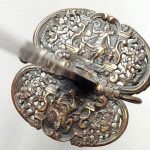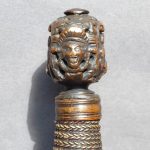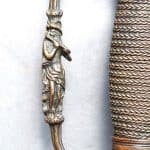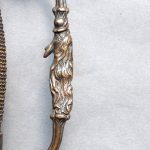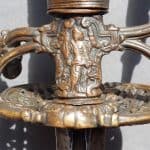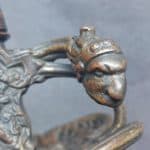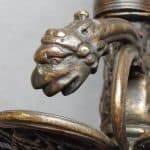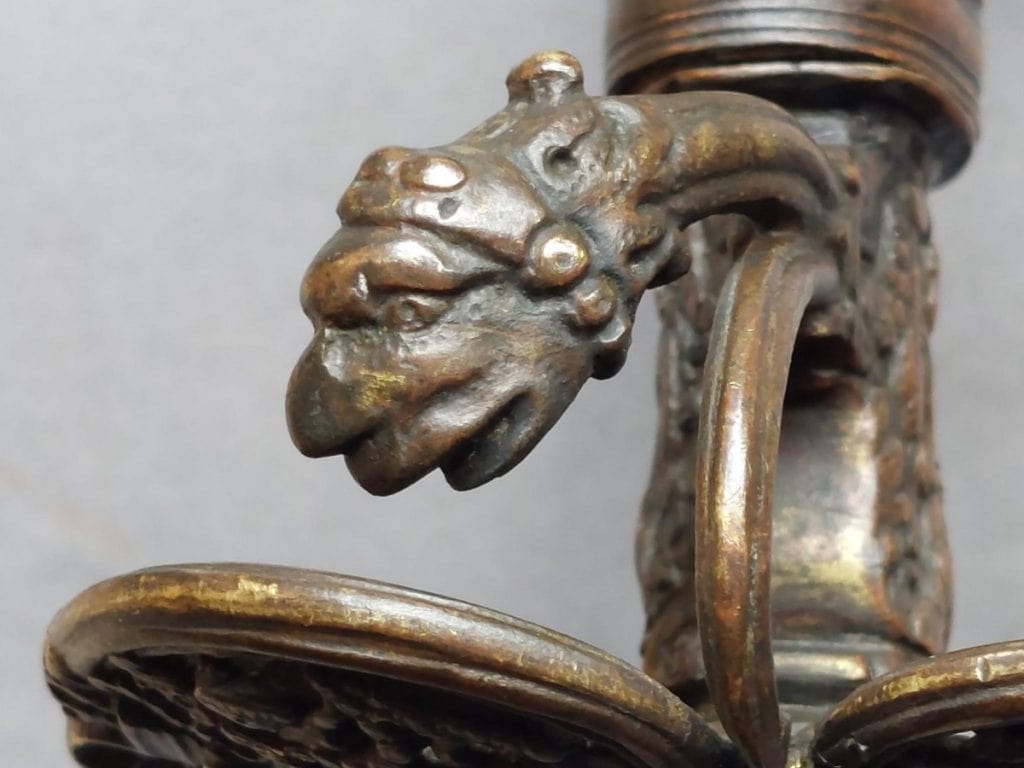
Late 17th Century Transitional Spanish Rapier / Smallsword With Bronze Hilt with Meso-American Symbols and SAHAGVM Blade
To enquire about this itemplease click here
Price: £3,950
Ref: 42020367
Item Description
A late 17th century Spanish Transitional Rapier / Smallsword with a Cast and Chased Bronze Hilt featuring a rarely encountered blend of Spanish Baroque Classical and Meso-American Inca and Aztec symbols and motifs. The sword is mounted with a fine late 16th century Spanish rapier blade.
The sword dates to the late 17th century. The hilt is of cast and chased bronze and is distinctive, possibly unique, due to its mix of styles and features incorporated into the hilt. The sword was most likely commissioned by a Spanish official with experience of Spain in its European context as well as its Central and South American dominions.
The hilt is formed around a bold quillon block with a thick oval plug which encases the lower part of the tang nearest the ricasso. Between the plug and the ricasso two robust shell guards are joined at the tang aperture. The outer shell which protects the fingers of a right-handed user is slightly larger than the inner shell guard which protects the thumb. To the front the knuckle bow emanates from the block and curves upwards to be secured into the pommel front with an integral terminal hook. The solid slightly flattened rounded square shaped pommel has its broadest faces to the front and back with its narrowest to the sides. It has an integral button on top and flared neck beneath. A quillon projects to the rear with a solid swollen terminal. Two pas d’ ane rings project from the block from underneath the knucklebow and quillon and curve downwards to terminate between the shell guards.
The shell guards have thickened rims and are intricately pierced. The larger shell on both sides depicts a seated robed classical deity with a child in a panel in the middle, flanked by dancing figures wrapped in garlands on each side. This feature is obviously influenced by the Spanish Baroque architectural style. The second shell has a slightly differently poised deity and instead of dancing figures on the flanks the space is fashioned with the inward-looking profile heads of Meso-American Indians. Front and back the block and pommel feature a similar robed deity with a child inside panels. To the sides of the pommel Aztec heads in feather headdress stare back at the onlooker. The pas d’ ane rings, knucklebow, shell guard rims and quillon are decorated with reeded lines. The knucklebow has a swelling in the middle shaped as a robed figure playing pipes and a swelling at the top shaped as a classical head from which the hook attachment to the pommel emerges. The swollen terminal of the canted quillon is shaped as an intimidating Inca warrior’s head.
The baluster shaped oval section grip is wrapped with pairs of contra-twisted brass ropes with wire spacers between. Ferrules are mounted top and bottom each decorated with similarly incised lateral lines.
The stiff gently tapering blade is of flattened diamond section and of high quality. It has a short ricasso and a pronounced deep fuller on each side which extends from the hilt for 8 inches (20 cm) until it tapers to a point beyond which two small anchor-like marks are stamped into the medial ridge on each side.
Clearly stamped into each fuller are the letters S A H A G V M flanked by crosses on each side. Despite the slight difference in spelling, “SAHAGVM”, is the mark of Alonso de Sahagún the Elder, an important Spanish swordsmith working in Toledo from circa 1570 to 1600. His mark, like the marks of other famous swordsmiths of the late 16th century, was copied by blademakers to follow as an emblem of quality. For example, it often appears on the blades of Dutch Walloon Swords of the mid-17th century.
Whilst it is difficult to attribute this blade to the original Sahagún, it is of undoubted high quality. It is similar to a late 16th century blade mounted onto a rapier in the Wallace collection (collection ref: A669), and another in the Victoria and Albert Museum (collection ref: M.91-1921) stamped ALONZO . DE . SAHAGUN . EN . TOLEDO, both attributed to this maker.
The blade is 35.75 inches (91 cm) long and overall the sword is 42.75 inches (108.5 cm).






